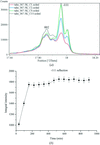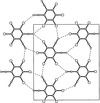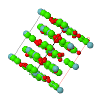issue contents
February 2009 issue

Cover illustration: Though cyclohexanol is a simple compound it has a rich phase diversity at low temperature. It forms a disordered glassy phase on cooling, but this can be transformed into ordered phases (II), (III) and the metastable (III'), which all have different hydrogen-bonding motifs. The series of transitions is attributable to the conformational flexibility of the hydroxyl group [Ibberson et al. (2008). Acta Cryst. B64, 573-582].
research papers
Download citation


Download citation


A new non-centrosymmetric high-pressure phase of the NLO compound α-BiB3O6 has been analyzed with the aid of a new method for automatic detection, calibration and evaluation of Debye–Scherrer ellipses using pattern-recognition techniques and advanced signal filtering.
Open  access
access
 access
accessCompounds with a `stuffed anti-bixbyite' structure, such as Li3AlN2, were analysed in terms of both the extended Zintl–Klemm concept and the coordination-defect concept. For the first time, inorganic crystal structures are seen as a set of `multiple resonance structures' (Klemm pseudo-structures) which co-exist as the result of unexpected electron transfers between any species pair comprising either like or unlike atoms, cations or anions. If this is the driving force controlling crystal structures, the conventional oxidation states assigned to cations and anions lose some of their usefulness.
Download citation


Download citation


The reported morphotropic phase boundary of KxNa1 − xNbO3 at x = 0.3 has been studied with powder X-ray and neutron diffraction.
Download citation


Download citation


Three polymorphs of K2Co2Mo3O12 are compared: the ambient-conditions phase α, a so-called `high-temperature' phase β, and a high-pressure phase II, formed at ca 6.7 GPa. Coordination polyhedra and packing schemes are compared for the three different network structures.
Download citation


Download citation


Using X-ray powder diffraction, differential scanning calorimetry (DSC)/thermogravimetry (TG) and single-crystal neutron diffraction, dynamic proton disorder and structural phase transition studies were carried out on (NH )
) H(SO4)2 between 293 and 493 K.
H(SO4)2 between 293 and 493 K.
Download citation


Download citation


The capabilities of the `method of crystallochemical analysis' are demonstrated with an example of all the pyridine-2,6-dicarboxylate containing complexes known so far; this method reproduces the structure and topology of any complex concisely.
Download citation


Download citation


Equimolar mixtures of ortho and meta, or ortho and para, or meta and para tetrachlorodicyanobenzenes form structures containing layers of disordered molecules with both kinds of molecule in the same layer, but which are otherwise similar in structure to one of the polymorphs of the pure meta isomer.
Download citation


Download citation


The evolution of the bond lengths, hydrogen bonds and thermal displacement have been accurately investigated over a wide temperature range (100–345 K) in order to better understand an original isosymmetric first-order phase transition of an m-CPAMP single crystal.
New automated methods are applied to analyse polymorphic structures in the Cambridge Structural Database, revealing that a large proportion of chemically equivalent hydrogen bonds persist in multiple structural forms. The roles of conformational variation, hydrogen-bond geometries and chemical functionality are systematically explored.
Download citation


Download citation


X-ray and circular dichroism (CD) investigations on diesters and diamides containing two ortho-(1,8-naphthalimido)benzoyl (NAB) bichromophores reveal the high complexity of the system and the conformational variety of the molecules, which makes reliable prediction of their shape difficult. The types of intermolecular interactions experienced by these molecules in a crystal have been summarized quantitatively by means of a Hirshfeld surface analysis.
short communications
Systematic differences between calculated bond-valence sums and stoichiometric valences, stoichV, which are e.g. observed in structures containing lone-pair cations, are due to differences between the values of structural valence, structV, and stoichV, caused by electronic effects. Optimization of bond-valence parameters should be based on values of structV instead of stoichV.
Using the least-squares refinement procedure, high-performance Brown–Wu bond-valence parameters, r0 and n, reported for the Sn2+/O2−, Sb3+/O2−, Te4+/O2− and I5+/O2− ion pairs have been converted into the commonly used bond-valence parameters, r0 and b. The r0 and b values obtained are recommended as a replacement for the conventional bond-valence parameters based on the `universal constant' b = 0.37 Å.
international union of crystallography
Free 



 journal menu
journal menu






























